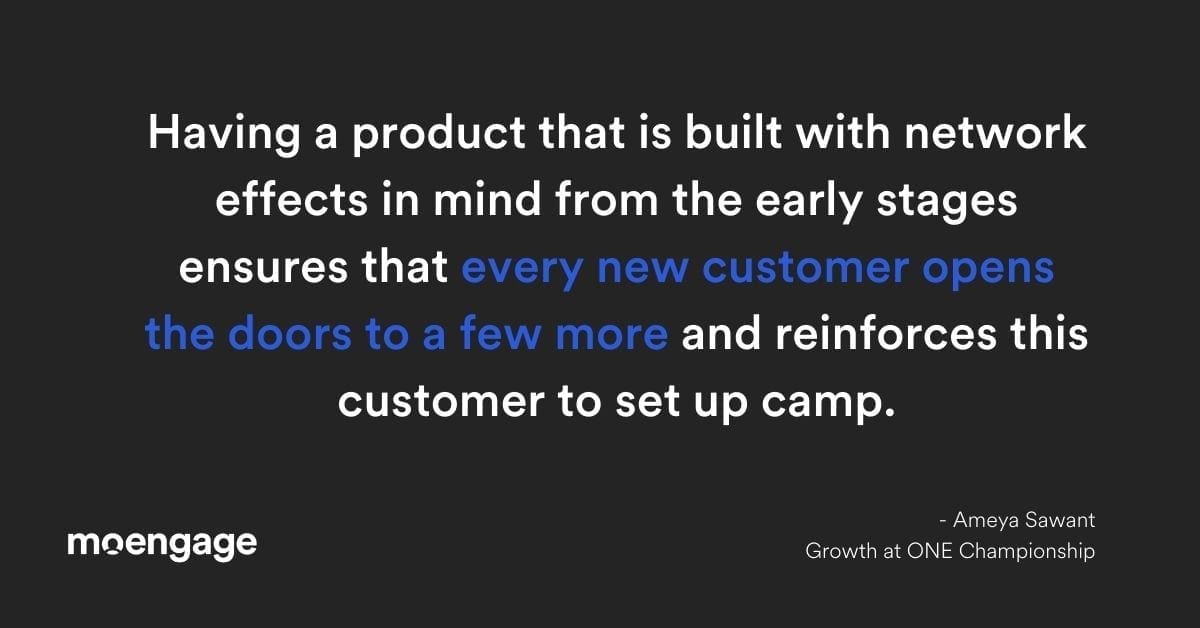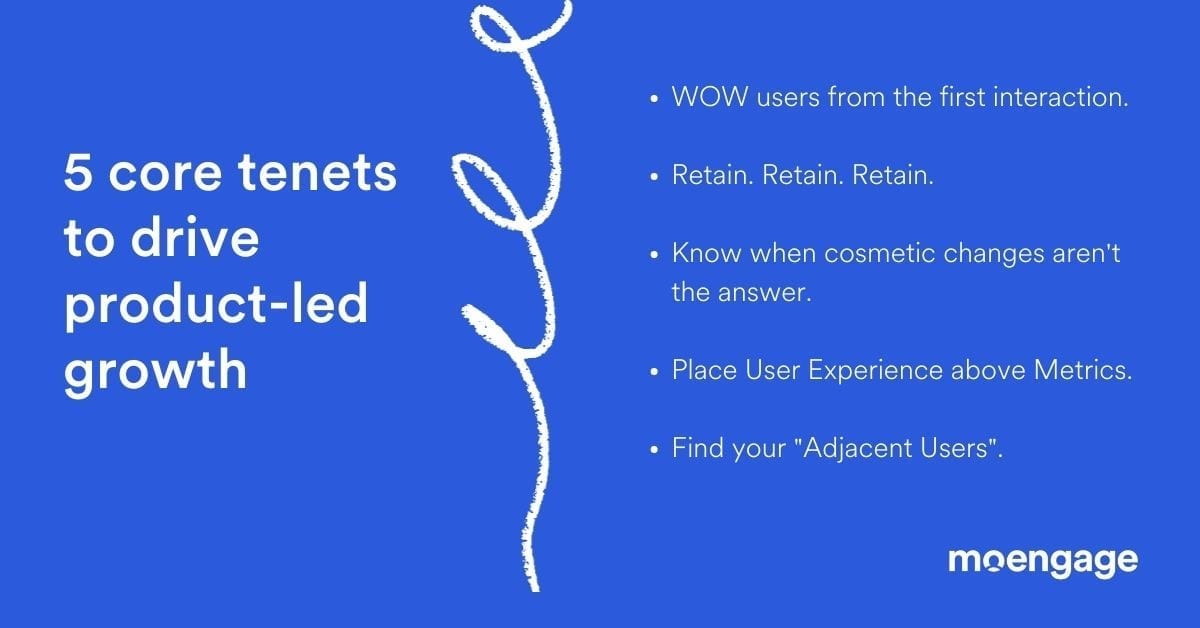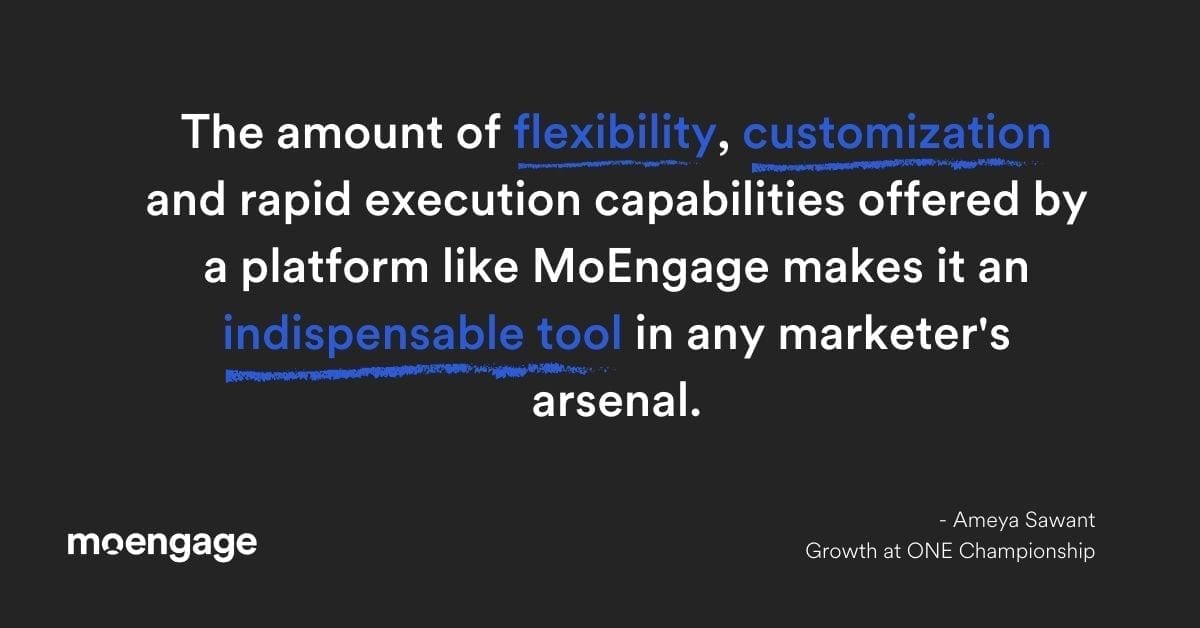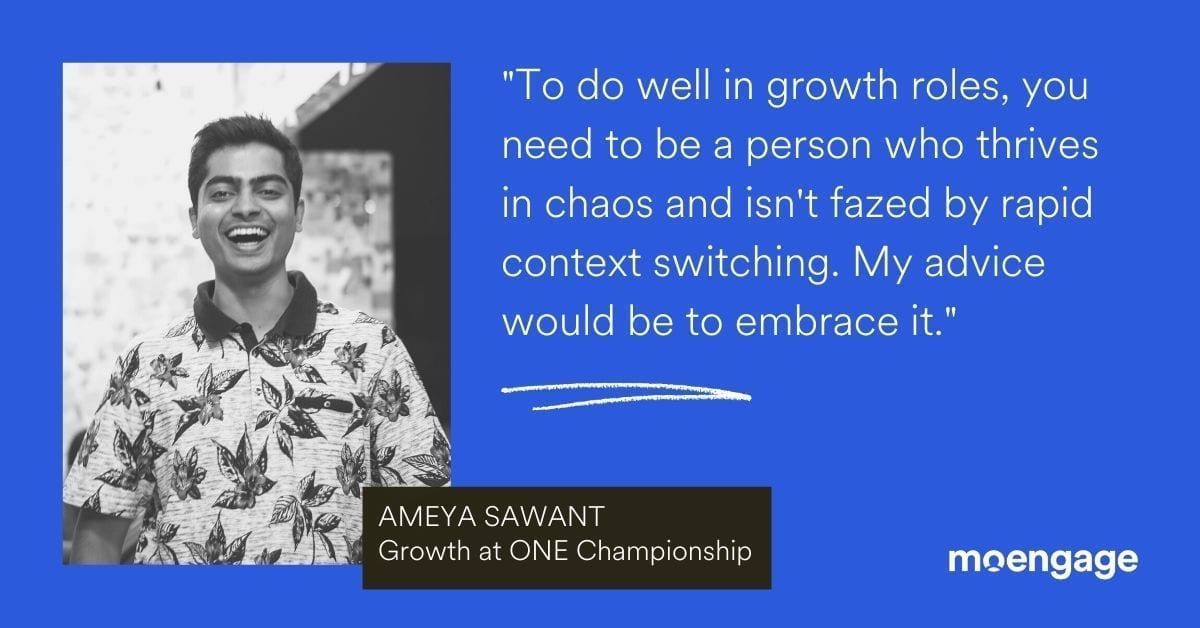Unraveling Product-led Growth Strategies [Marketer Spotlight]
![Unraveling Product-led Growth Strategies [Marketer Spotlight]](https://www.moengage.com/wp-content/uploads/2020/10/Ameya-Sawant.gif)
Reading Time: 7 minutes
Editor’s note: What are some names that come to your mind when you think of product-led growth? Slack, Drift, or some other B2B product, maybe? While there are many advocates in the SaaS world, the concept can also be applied to place a consumer app on the growth trajectory.
I got the opportunity to interview one such product leader who believes a product-first approach is always the most successful growth strategy. He’s implemented this strategy for the projects he’s led and has some exciting insights to share. Please welcome Ameya Sawant, who’s worn multiple hats across product and marketing functions for verticals such as travel, ed-tech, and, most recently, the sports industry.
| Bonus Content
👉 Definitive Buyer’s Guide To Customer Engagement Platform [Download Ebook] |
Please share a brief introduction about yourself and some projects you’re currently working on.
Ameya: I have been in the startup world throughout my career. I spent time helping build Treebo’s B2B arm and later picked up the digital app ecosystem’s know-how at Vedantu in the Ed-Tech space. From there, I jumped over to the world of sports in the past year.
My pocket ace is that I can understand and interpret data well – either this comes naturally to me or drilled into me over the past four years.
Currently, I handle Growth and Special Projects at ONE Championship in Singapore. For those who are not familiar, ONE Championship is Asia’s fastest-growing global sports media property. We are also Asia’s largest martial arts company, with over 90% market share. We have around 40+ events every year and broadcast to over 150 countries.
With a small Product and Engineering team based across Singapore and India, we help introduce the world of martial arts to a host of new technologies with the fan’s digital experience taking centerstage.
There’s much discussion about product-led growth in the B2B SaaS space. But what does this mean to a consumer app, and why is it important?
Gun to my head, I’d say the best kind of growth is led by product. This is true both in the direct to consumer world as well as in the B2B world.
Business growth typically led by sales or marketing channels comes at far higher costs. In most cases, it is unsustainable and hollow unless the product can rise to the occasion. For example, typical customer acquisition costs are 5x retention costs. This means, unless your pockets are overflowing with capital, you shouldn’t be eyeing sales/marketing-led routes purely to drive growth.
There have to be reliable business/strategic upsides (e.g., small TAM, first-mover advantage, high switching costs) to choose sales/marketing over product-led growth.

Product-led growth in the B2C space relies heavily on two things – the product-market fit and the degree of inbuilt network effects. An excellent product that consumers badly need ensures that the spending you do on acquiring new users isn’t flowing down the advertisement rabbit hole. Having a product that is built with network effects in mind from the early stages ensures that every new customer opens the doors to a few more and reinforces this customer to set up camp.
With a product-led approach, you’re ensuring that the product and your customers drive growth for you, which is a much more reliable and efficient way to grow your business.
What are the core elements of product-led growth for consumer brands?
The ability to truly understand your product’s end-users’ motivations and drivers lies at the heart of this approach. Consumer psychology for a fitness product is drastically different from that for a grocery subscription service and miles apart for new hardware.

But certain tenets hold for any consumer brand’s product-led growth:
- ‘Wow’ your users right from the first interaction.
- Retain, retain, and retain.
- Know when cosmetic changes aren’t the answer.
- Place User Experience above Metrics.
- Find your “Adjacent Users.”
What is the role of a product manager in driving growth?
I believe that growth is a function of the product itself. The extent to which consumers love your product and how tightly they latch on to it directly correlates with the product’s quality, and Product Managers (PM) are your chaperones on this path.
A single quarter of on-the-money decision making by this team can move your company miles in the right direction.
Many times, prioritizing a housekeeping sprint for the codebase at the right time over the obscure new feature that might work could mean the difference between temporarily pleasing a vocal cohort of users and turning a laggy system into a snappy for every single user.
That said, the growth process is a series of continuous cross-functional experiments. Core PMs are closely involved in setting the business up for success. At the same time, the growth function ensures that their product KPIs are bringing enviable overall progress to the company.
How important is good collaboration between the Product and Marketing teams to drive growth?
This question is always a little funny. It’s akin to asking the importance of collaboration between Product and Engineering. Your marketing department is the megaphone for the product built by the engineering team. A brilliant product with no marketing is as wrong as a terrible product with great marketing. The first one doesn’t change the world effectively, and the second aims to make a quick buck at the expense of your customers.
“Good Collaboration” is the outcome. The cause is excellent communication. For marketing to work well, that team must be deeply familiar with the product and its upcoming milestones. When this does well, all marketing channels function like clockwork and leave the team with enough headroom for creativity, and this is typically where the magic happens.
Watch Ameya describe how a strong collaboration between Product and Marketing teams can influence CX:
What are the internal friction points, and how can you overcome them?
Typically, friction points present themselves under the ruse of process, diligence, email approvals, and “because we have always done it that way.” Though important, if left unchecked, you could find your team using these as reasons to justify delays.
While it’s good to rely on a structured approach for critical decisions, I find that things are quicker and more precise over a voice call from personal experience. You’d be surprised how many people don’t mind a quick call than a long drawn text battle.
When you scale your app from 10K to say 100K – what changes from a product-led growth perspective?
First and foremost, the share of mind space that data occupies in your decision-making process begins to grow. At smaller scales, the raw strength of your hypotheses is the influencer of product decisions. However, as you grow and scale, the reliance on quantitative methods should also increase.
Second, these are good times to check how robust your functional systems are before you aim for what I call the leap of scale.
There’s a fascinating example presented by John Foley, the Founder & CEO of Peloton. Foley speaks in the context of user-facing leaderboards (or ranking systems in games and gamified products) and brings forth the concept – “impotence of abundance.”
A leaderboard with hundreds of thousands of people isn’t that motivating, incrementally more than 2000 people. It may be less valuable because you feel less intimate and less connected. So if you compare and rank your customers in any fashion, the scale will make your leaderboards a liability much quicker than you can imagine.
The way you address problems like these determine the steepness of your next product-led growth curve. Keep in mind that your future 10x jumps depend on the nature of network effects embedded in your current product/business.
How does an engagement platform like MoEngage help in driving product-led growth?

Serving the right set of customers with the right message at the right time is a crucial piece for effective retention. An out of the box specialized solution for this works leagues better than building a communication layer of your own. The amount of flexibility, customization, and rapid execution capabilities offered by a platform like MoEngage make it an indispensable tool in any marketer’s arsenal. But these tools work only as well as the team wielding them. Hence, the platform must act as a natural extension of the product.
What’s your advice to product managers who also want to put on the growth hat?

The literal Growth hat is like Godric Gryffindor’s sorting hat from Harry Potter. The difference is, you don’t just select one house (branch of work) permanently. Instead, you have to put the hat on multiple times in a day and focus on different things. There’s marketing requirements, budgets, blue sky stuff to look after. There’s also the product upgrade shipped last week and two more lined up for this month. What about negotiating the SaaS tool’s contract that is near expiry, interviewing those analyst candidates – the list is endless, and there’s always something bright and shiny around the corner. If you thrive in chaos and aren’t fazed by rapid context switching, you’ll do well in growth roles. My advice would be to embrace it.
“In this world, you’re either growing or you’re dying so get in motion and grow.”
― Lou Holtz
Thank you, Ameya, for sharing your thoughts and advice. I’ve learned a lot about driving growth through a product-first approach. I’ve also understood this is one of the most reliable growth strategies that can offer long-term benefits. I’m sure our readers will benefit from the insights you’ve shared.
Readers, you can connect with Ameya for more tips and advice around product, growth, and user retention tactics.
Here’s what you can read next:
|













